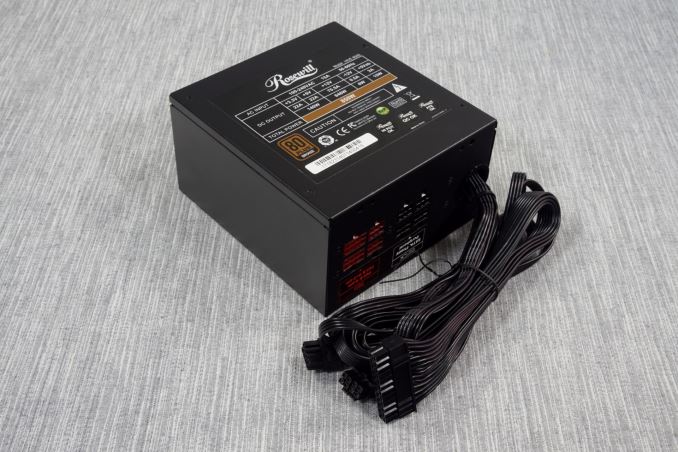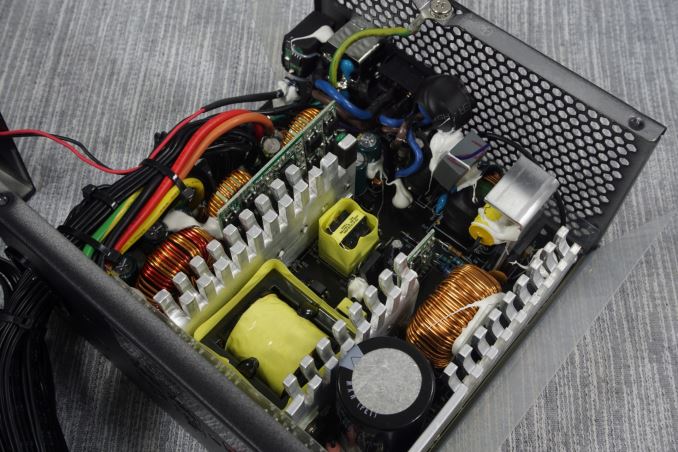The Rosewill Hive 850W PSU Review
by E. Fylladitakis on July 28, 2015 9:00 AM EST- Posted in
- PSUs
- Cases/Cooling/PSUs
- Rosewill
- 850W
Conclusion
Bringing our review of the Hive 850W to a close, perhaps the best jumping-off point is to start with the underlying platform itself, the Direct12 Bronze v.2.
Overall the platform the Hive 850W is based on is not bad, just somewhat outdated. Sirfa designed the Direct12 Bronze v.2 platform a couple of years ago, to compete with other 80Plus Bronze certified products at a time when technologies that are more efficient were very costly. This is why the PSU implements technologies that are normally reserved for higher performance units, such as DC-to-DC conversion circuitry. They were inserted in order to provide a performance edge over other platforms available at the time without creating a very expensive product. At the same time, the inversion/conversion circuits are using active components that are not very efficient. Their high energy losses generate significant amounts of heat, with that heat further decreasing their efficiency, creating a cascading effect when the PSU is heavily loaded.
We cannot complain at all about the quality of the Hive 850W PSU. It is not the best that it could be, but it is very good and certainly on par with other similarly priced products. The OEM is reputable, the components are of very good quality and the assembly job is excellent. What the Hive 850W could use is better heatsinks, but that is a design/performance issue, not a sign of bad quality. It does work fine with its current heatsinks, but the brunt of the cooling requirements falls on the fan, forcing it to spin very fast and becomes very loud if the Hive is under very heavy load or installed in harsh ambient conditions. The Hive generally is quiet when lightly loaded, as the fan does not have to work as hard to dissipate the heat. As such, the Hive 850W displays troubling thermal behavior and mediocre acoustics performance.
As for its electrical performance, it is good but uninspiring by today's standards. We recorded very low voltage ripple levels and found the output power quality of the Hive to be very good, even considering the higher ripple that we saw with the unit heavily cross-loaded. The regulation of the voltage lines could be improved, as it is acceptable but not really good for a high performance PSU. Finally, the electrical conversion efficiency is obviously not competitive against the newer, more advanced platforms available today, but it is good for an 80Plus Bronze certified unit and meets the performance levels it is supposed to.
Rosewill designed the Hive 850W mainly to lure mainstream users and enthusiasts on a tight budget. The primary purpose of this PSU is to entice via its good value. As such, it is not a top performer, as it was never meant to be. However, the retail price of $100 including shipping is not particularly cheap, even for an 850W PSU. Considering that the target group of the Hive 850W PSU is enthusiasts with rather powerful gaming or professional systems - users that often don't mind spending a little extra for a high quality product - it will be very hard for Rosewill to convince them that the Hive 850W is the right choice for them. On the other hand, if someone is on a very tight budget, other companies are lurking with equally well-made products at even lower prices. At the time of this review, EVGA is offering the SuperNova 850 B2 for $90 incl. shipping and 800W LEPA MaxBron similarly retails for $90 incl. shipping. If the retail price of the Hive 850W were to drop a little, it could compete in terms of value with the rest of the 800-900 Watt PSUs. Otherwise in terms of overall performance, it may not generally be a bad performer, but it does not really stand a chance against the more advanced platforms available today.












24 Comments
View All Comments
DanNeely - Tuesday, July 28, 2015 - link
This is the first PSU I've seen using flat ribbons for the 24pin ATX cable. Is it able to alleviate the stiffness that normally makes the sleeved monster such a pain to route behind things?piasabird - Tuesday, July 28, 2015 - link
Silverstone makes a set of flexible flat ribbon cables that are of a shorter length for use with their fully modular power supplies. Silverstone PP05-E 0.98 ft. Flat Flexible Short Cable Set for SilverStone Modular PSUs. http://www.newegg.com/Product/Product.aspx?Item=N8...DanNeely - Tuesday, July 28, 2015 - link
Do they sell individual cables, IIRC my PSU is a Silverstone and it is modular; but all my smaller cables are the flat type. Only the 24pin legacy cable is the fat sleeved style.Cellar Door - Thursday, July 30, 2015 - link
Thank you Sir!meacupla - Tuesday, July 28, 2015 - link
It has its own set of benefits, but also has some drawbacks.Overall, I think individual strands are the easiest to work with, but only if they neatly come out of the PSU. Otherwise, the ribbon is moderately easier to work with than sleeved.
Impulses - Tuesday, July 28, 2015 - link
I dig that flat ribbon, specially with today's cases that have plenty of cable holes... I still don't get why individually sleeved strand cables got so popular, they look ok if you have combs in them to keep them very straight but with or without they're still bulkier and harder to hide.We moved away from PATA cables for a reason and the current craze over single strand braids basically leaves them looking like fancy PATA cables (that you can't fold as easily as the old thin PATA cables).
meacupla - Tuesday, July 28, 2015 - link
The move away from PATA cables was because of ease of installation, rather than how poorly they could be routed.In fact, PATA cables were a lot easier to work with. Done right, they were far less restricting to airflow than spliced and bundled cables.
extide - Tuesday, July 28, 2015 - link
The move away from PATA had pretty much zero to do with aesthetics or installation ease. It's purely an engineering reason why we moved from a slow parallel bus to a fast serial bus. Those other reasons are purely side benefits.meacupla - Wednesday, July 29, 2015 - link
you say that, but at that point in storage technology, the disks were barely saturating 66Mbps and it took intel, nvidia and VIA quite a while to implement SATA as a native feature in their chipsets.Impulses - Thursday, July 30, 2015 - link
That was my point, we used to splice and play origami with PATA cables to avoid that big chunky flat cable look that the fancy braided cables now end up replicating...